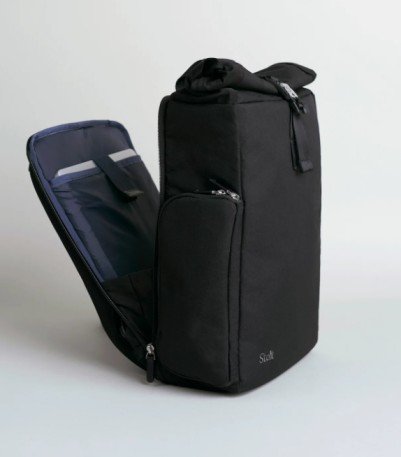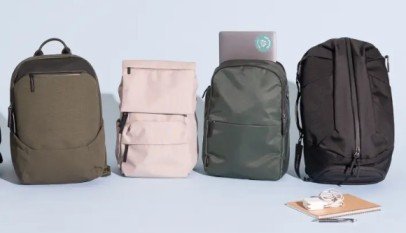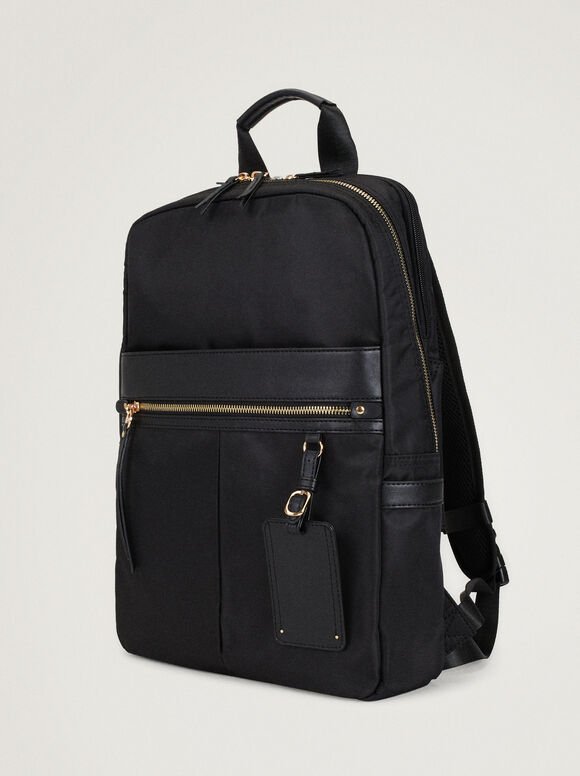
In a market teeming with competition and ever-evolving consumer preferences, the ability to source materials, manufacture products, and distribute them effectively becomes paramount. The supply chain’s efficacy doesn’t just determine the pace of production; it dictates the ability to innovate, meet market trends, and most crucially, ensure product availability to the global audience. As we delve deeper into the world of laptop backpacks, we’ll uncover the intricate dance of challenges and opportunities that suppliers navigate, all in pursuit of that perfect backpack for the modern consumer.
1. Challenges in the Supply Chain
a. Raw Material Sourcing
The foundation of any product lies in the raw materials from which it is crafted. For laptop backpacks, this typically means fabrics, zippers, padding, and various other components.
- Ensuring sustainable and ethical sourcing: As global awareness about environmental and ethical concerns grows, there is mounting pressure on suppliers to source materials responsibly. This means avoiding materials that harm the environment, ensuring that they’re renewable, and verifying that they’ve been produced under fair labor conditions. Meeting these standards, while essential, can be challenging given the vastness and opacity of global supply chains.
- The volatility of raw material prices and their impact: Materials like metals (for zippers and buckles) or specific fabrics can experience price fluctuations based on global demand, geopolitical events, or natural disasters. These fluctuations can pose challenges in pricing the final product, maintaining profit margins, and ensuring steady production.
b. Manufacturing Complexities
The assembly line is where design meets reality, and it’s rife with challenges.
- Adapting to changing designs and technological integrations: As laptop backpacks evolve, incorporating new features or materials, manufacturing processes must be updated. This demands flexibility, continuous training of staff, and often, investment in new machinery or techniques.
- Balancing quality with cost-effective production: High-quality products command consumer trust, but quality often comes at a cost. Manufacturers constantly grapple with the task of producing top-notch backpacks while keeping production costs in check to maintain competitive pricing.

c. Logistics and Distribution
Once produced, products need to reach retailers and customers, a journey fraught with its own set of challenges.
- Meeting global demand and managing international shipments: As brands grow and cater to a global audience, they must navigate the complexities of international shipping, customs, and tariffs. This requires a deep understanding of international trade regulations, reliable shipping partners, and efficient tracking systems.
- Warehousing challenges and inventory management: Storing products until they’re shipped is an art in itself. Warehouses must be spacious, secure, and conducive to preserving product quality. Additionally, effective inventory management ensures that there’s neither an excess nor a shortage of products.
d. Quality Control and Standards
Maintaining consistency and adhering to international standards is crucial for brand reputation and customer safety.
- Ensuring consistent quality across batches: With large-scale production, ensuring that every single backpack meets the desired quality benchmarks is challenging. This demands rigorous quality control measures and regular audits.
- Meeting global standards and certifications for safety and durability: Different regions have varying standards for product safety and durability. Manufacturers must be cognizant of these when producing for an international market to avoid recalls or legal complications.
e. Consumer Expectations and Trends
The end consumer’s preferences can be as dynamic as the market itself, often setting the course for the entire supply chain.
- Rapidly changing market dynamics and design preferences: Trends come and go. Today’s hot-selling design could become obsolete tomorrow. Keeping pace with these shifts requires agile design, production, and marketing strategies.
- Addressing the need for sustainable and eco-friendly products: Modern consumers are increasingly eco-conscious, demanding products that have a minimal environmental footprint. Meeting this demand means revisiting every step of the supply chain, from material sourcing to packaging, to ensure eco-friendliness.

2. Opportunities in the Supply Chain
a. Technological Integration
In an era where technology permeates almost every facet of our lives, the supply chain stands to gain immensely from its advancements.
- Use of AI and big data for demand forecasting: Predicting market demand has always been a blend of art and science. With AI and big data, suppliers can now analyze vast datasets from past sales, online trends, and even social media chatter to predict future demand with greater accuracy. This aids in reducing overproduction or stock shortages, ensuring a just-in-time inventory approach.
- Automation in manufacturing for consistent quality: Robotics and automated machinery can handle repetitive tasks with precision. By integrating these into the manufacturing process, suppliers can achieve consistent product quality, reduce human errors, and even speed up production cycles.
b. Sustainable and Ethical Production
Being ‘green’ isn’t just a trend; it’s becoming a market expectation, opening avenues for differentiation and brand loyalty.
- Capitalizing on the growing demand for eco-friendly products: As consumers lean towards sustainable choices, suppliers can cater to this demand by producing backpacks from recycled or eco-friendly materials, ensuring a smaller carbon footprint.
- Building brand reputation through responsible sourcing and production: Ethically sourced materials and fair labor practices not only benefit the environment and workers but also elevate the brand’s image. A positive brand reputation can translate to customer loyalty and premium pricing.

c. Direct-to-Consumer (DTC) Models
The rise of online shopping has enabled suppliers to reach consumers directly, bypassing traditional retail channels.
- Reducing middlemen, improving profit margins, and enhancing customer relationships: By selling directly to consumers, brands can gain better profit margins, have direct feedback loops, and create personalized marketing campaigns, fostering a closer relationship with their customer base.
d. Localized Manufacturing
With globalization, there’s a newfound appreciation for local solutions, given their unique advantages.
- Addressing local market needs more efficiently: Local manufacturing units can adapt faster to local market trends and preferences, allowing for quicker design-to-market times.
- Reducing logistics costs and environmental footprint: Producing closer to the consumer reduces transportation distances, leading to lower shipping costs and a reduced carbon footprint, aligning with the sustainable production ethos.
e. Collaborations and Partnerships
Two heads are often better than one, especially when bringing combined expertise to the table.
- Teaming up with tech companies for integrated features: As laptop backpacks become techier, collaborations with tech firms can lead to innovative features, such as integrated power banks, smart locks, or even IoT-enabled tracking.
- Co-branding opportunities for market expansion: Partnerships with popular brands in adjacent industries can introduce the product to new audiences. For example, a laptop backpack brand collaborating with a renowned tech company or a popular fashion label can tap into their respective loyal customer bases.
3. Case Study Highlights
The laptop backpack industry, like any other, has its shining stars — brands and companies that have not only weathered supply chain storms but have turned challenges into opportunities, setting benchmarks for others. Let’s delve into a few such trailblazers.

1. Samsonite: Embracing Sustainable Production
A titan in the luggage industry, Samsonite’s foray into laptop backpacks brought the same commitment to quality and innovation. They recognized the growing demand for sustainable products and launched their Eco-Nu line made entirely from recycled PET bottles. By turning to sustainable materials, Samsonite not only catered to eco-conscious consumers but also stabilized their raw material sourcing, mitigating the volatility associated with non-renewable materials.
2. Herschel Supply Co.: Direct-to-Consumer Model Mastery
Herschel leveraged the power of digital commerce early on. Bypassing traditional retail channels, they connected directly with their consumers. This DTC approach allowed Herschel to gather real-time feedback, iterate product designs quickly, and foster a strong brand community. Moreover, the reduced dependency on middlemen improved their profit margins significantly.
3. Targus: Localized Manufacturing & Global Reach
Understanding that different markets have distinct needs and preferences, Targus set up localized manufacturing units across key markets. This allowed them to cater to regional tastes effectively, ensure faster delivery, and reduce logistical costs. Their CityLite Pro collection, for instance, varied slightly across regions, showcasing their commitment to localized customization.
4. Osprey: Collaboration with Tech for Integrated Features
Osprey, known for its robust outdoor backpacks, recognized the growing segment of digital nomads and remote workers. Collaborating with tech companies, they integrated features like solar-powered USB charging ports and RFID-blocking pockets into their laptop backpack lines, offering a blend of outdoor ruggedness with urban tech-savviness.
4. Conclusion
In essence, as suppliers in the laptop backpack industry, our narrative is one of relentless evolution, guided by a commitment to excellence, innovation, and, most crucially, an unwavering focus on delivering value to our customers. The path ahead is replete with both challenges and opportunities, and we are poised, ready, and excited to embrace what’s next.
Airscape Textile stands at the forefront of the laptop backpack industry, blending unmatched quality with contemporary design. We pride ourselves on using top-tier materials, ensuring durability while championing ethical and sustainable production. With an emphasis on innovation, our offerings can be tailored to align with individual brand identities. Despite our commitment to excellence, we ensure competitive pricing, making us the go-to choice for both emerging and established brands. Partner with Airscape Textile for a seamless journey from conceptualization to post-purchase support, all anchored in excellence. Contact us now by filling out the form on this page or just click here.


